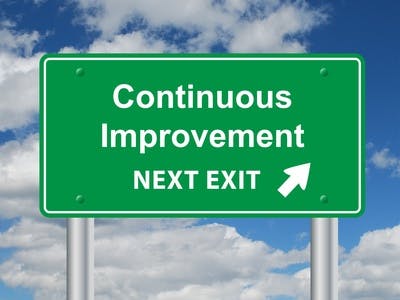No one has the luxury of remaining at status quo.
If you’re not improving, you’re falling behind. It takes effort and work to take personal responsibility for your own growth and relevance, but it’s much more complex when you have to bring an entire organization along with you.
One way to drive organizational improvement is with projects — get the right people together and let them solve a problem. I believe every organization needs to do this on a regular basis, but I don’t think it’s enough. These periodic improvement events should be enhanced with kaizen, where every person at every level of the company is working every day to make things better.
4 things to make improvement happen
It’s what our founder, Obert C. Tanner, was referring to decades ago when he asked us to seek for “a future better and beyond our present best.”
Here are four things you need to make this happen:
- A clear vision and direction;
- A powerful reason to get there;
- Good methodology for how to go about it; and,
- A desire to do it.
Clear vision
Make sure there is no question as to what the desired outcomes will be. One way to provide clarity is with “true north” statements.
Here are some that are common in manufacturing: zero injuries and illnesses; 100 percent quality; zero defects and returns; and 100 percent value-added: one-piece flow on-demand. Such statements are highly aspirational and are clear regarding the direction we need to be moving.
A powerful reason
Do you have a compelling statement that describes why you do what you do and why it matters in the world? This provides a “higher purpose” for the work your employees do every day, and makes it important in their lives.
The greatest engagement comes from being part of something bigger than yourself. Make sure your people can find meaningful purpose in what they do.
Good methodology
Empowerment is preceded by trust. You can’t empower people to go to work on issues until you trust that they understand your methodology for problem solving. Otherwise, they may end up using their empowerment to chase the wrong things the wrong way.
You solve this with clear expectations and solid training and development. Cutting corners here can lead to confusion and wasted time.
Desire
Finally, your people have to WANT to do it. They have to care about it.
I’ve seen two very important elements to this.
The first is that it has to be safe for them to venture into unknown territory and perhaps make some mistakes. It not only has to be safe, it has to feel like wondrous exploration and learning.
The second is that whenever someone (or a team) engages in continuous improvement you have to express appreciation for their great work, and you need to do it publicly. Everyone needs to see that those who improve things are honored and valued.
Clear Vision, Powerful Reason, Good Methodology, and Desire are the four things I’ve noticed that are a part of a high-performing culture of continuous improvement. I don’t know if there’s a correct or best sequence for implementing them — my guess is you could start with any of them — but I do have a feeling they are all important, and that missing one of them could mean you miss out on the results.
Ask yourself: What have you done to successfully use one of these four elements? Are there other things you’ve found to be essential for continuous improvement?
This was originally published on the OC Tanner blog.
